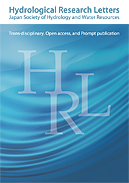
- Issue 4 Pages 55-
- Issue 3 Pages 41-
- Issue 2 Pages 14-
- Issue 1 Pages 1-
- |<
- <
- 1
- >
- >|
-
Yuta Tamaki, Masaru Inatsu, Tomohito J. Yamada2019 Volume 13 Issue 4 Pages 55-61
Published: 2019
Released on J-STAGE: October 16, 2019
JOURNAL OPEN ACCESS
Supplementary materialMotivated by the problem of rainfall duration bias typically found in dynamical downscaling, its possible effect on hydrology was evaluated for heavy rainfall events over Kyushu, Japan, during summer. Heavy rainfall in western Kyushu is often related to a persistent Baiu rainband across Kyushu, while in eastern Kyushu it is related to the passage of typhoons near Kyushu. For typical heavy-rainfall periods, we ran a tank model for several target rivers to analyze runoff and water-depth sensitivity to the hyetograph by artificially extending the rainfall duration to 8 hours while maintaining the same total rainfall. This showed that a spike in peak runoff was suppressed by prolonged weak rainfall as typically found in downscaling outputs. The timing of rising runoff and water depth in the tank model was shifted earlier.
View full abstractDownload PDF (10300K) -
Chris Leong, Yoshiyuki Yokoo2019 Volume 13 Issue 4 Pages 62-68
Published: 2019
Released on J-STAGE: November 21, 2019
JOURNAL OPEN ACCESS
Supplementary materialSeeking a process-based understanding for the shape of the flow duration curve (FDC) uniqueness to a catchment, this study applied a data-based rainfall-runoff modeling approach in perennial, intermittent and ephemeral catchments which would have different dominant rainfall-runoff processes. Using this approach, we identified (1) the number of dominant runoff processes in a catchment, (2) rainwater storage in all processes, (3) infiltrations and return flows between the processes. We then identified reasons for different FDC shapes in the catchments in terms of identified dominant processes. Our results showed a humid climate with lower aridity index (AI) would cause perennial flow created by the combination of four dominant processes of fast flow, faster and slower interflows and base flow components. On the contrary, an arid climate with higher AI would cause ephemeral flow created by the combination of two dominant processes of fast and faster interflow components. These indicate a FDC in arid catchments would become ephemeral because of less dominant runoff processes occurring only near ground surface, whereas a humid catchment would become perennial because of more dominant runoff processes occurring from near ground surface to deep underground. These findings contribute in estimating FDCs in ungauged catchments from climatic conditions.
View full abstractDownload PDF (1400K)
- |<
- <
- 1
- >
- >|